new posts in all blogs
Viewing: Blog Posts Tagged with: Georgia, Most Recent at Top [Help]
Results 1 - 17 of 17
How to use this Page
You are viewing the most recent posts tagged with the words: Georgia in the JacketFlap blog reader. What is a tag? Think of a tag as a keyword or category label. Tags can both help you find posts on JacketFlap.com as well as provide an easy way for you to "remember" and classify posts for later recall. Try adding a tag yourself by clicking "Add a tag" below a post's header. Scroll down through the list of Recent Posts in the left column and click on a post title that sounds interesting. You can view all posts from a specific blog by clicking the Blog name in the right column, or you can click a 'More Posts from this Blog' link in any individual post.
The Devon Horse Show grounds are empty, but the gates are open. No, not empty, we discover; there is a single contractor working within. With his permission we walk, in and out of the stables, the new buildings, the old ones. I find a ladder and Bill climbs it into a secret place. I think an abandoned sink is lovely. Also a discarded, woven hat. Also emptiness as countered by the milk of contained light.
In the sun it is hot. In the shade it is perfect.
What are we searching for on this Labor Day?
I have been reading Olivia Laing. I have been reading (I seem to endlessly circle her) about Virginia Woolf. Her ecstasy. Her mourning. Her river and her pocketful of stones. I have been reading, too, about artists, jealousies, rivalries. Bacon and Freud. Manet and Degas. I have been thinking of the panel I was on, just yesterday afternoon, at the exquisite AJC Decatur Book Festival, and all the things I didn't say, and the friends who came to see me, and the ease of our stupendously fine moderator, Terra Elan McVoy, who brilliantly coined perfumes for us and wove a silk thread between stories for us and wondered about our books as films and decided
This Is the Story of You isn't really a film, not yet a film, though perhaps it is an Indie. Yes. Always. I am, will be, the Indie. Slightly out of step and over to the side and stewing inside the next act of making something, my preference, always, for the thing that is not yet made, as opposed to the thing that is.
Do we read our books after they are published (beyond when authorial responsibility calls us to), we were asked. No, I said. No, emphatic. For there is no fixing the book then, no new chance, and I always wish that my books were better than they were, and I am always trying, until they are printed (ask any editor of mine) to make them better than they are, than they will be, but yesterday, when I was feeling, I'm not entirely sure why, sad, there was a girl in the line after the panel who asked me to sign her books. "You are my favorite author," she said, and I was stunned by it, set back, this gesture of hers, this kindness extended. Words that pinned me to the present time, for that present time, in that moment. With me on one side of the table and this beautiful girl on the other, for just that moment or two, I was me, with the books I have made, in the present, in the moment. I was not looking past them.
Not yet, anyway.

Partially packed, but ready to go.
This month my family and I returned from our LONGEST ROAD TRIP EVER. Longest in duration (one month), if not in miles (3,033).
We started from our home base in Rockford, IL and drove through eight states: Illinois, Indiana, Kentucky, Tennessee, N. Carolina, S. Carolina, Georgia, and Florida, stopping in various towns along the way. What were some of the biggest differences between all these states? Well the gas price for one thing: varying by 60 cents, and the temperature: a high of 104 ° F in Georgia and a low 48 ° F in Illinois. Our journey looked like this:

The long and winding road.
Did I mention there are five of us? By the time we were done, as you can imagine, we pretty much had had enough “family time”. There is a phenomenon known as too much vacation. When we finally got home we didn’t even unpack. Instead we separated to our individual rooms.
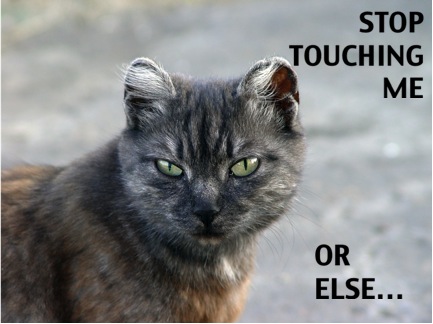 Although we were glad our trip was over, we did accumulate some great memories along the way. Like when we went to the Driftwood Beach at Jekyl Island. Very hot day, very cool views.
Although we were glad our trip was over, we did accumulate some great memories along the way. Like when we went to the Driftwood Beach at Jekyl Island. Very hot day, very cool views.

Driftwood Beach, Jekyl Island, GA
And walking the beach while the sun set over the Gulf of Mexico. Phenomenal. I’d honestly never seen sand turn pink before.

Sunset at the beach, St. Petersburg, FL
And of course a trip to Florida is never complete without a jump over to Orlando. For . . . you know . . . Harry.
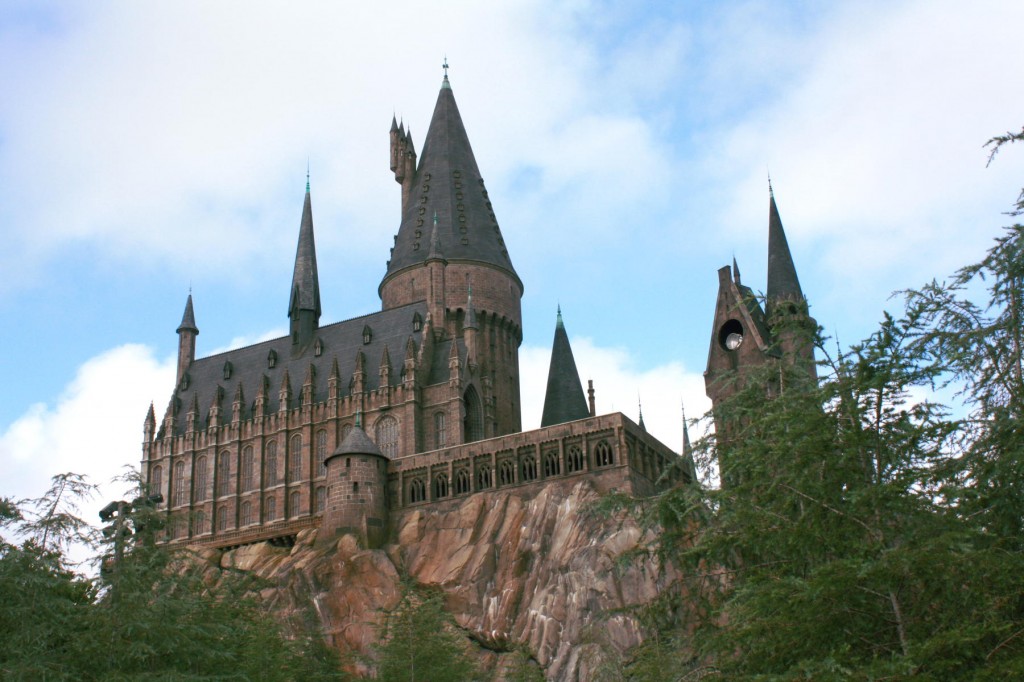
Hogwarts castle, World of Harry Potter, Universal Studios, Orlando, FL
My enthusiasm at World of Harry Potter easily trumped my kids’. One of my favorite memories was having a woman’s portrait in the Hall of Portraits blink when I took her photograph using my flash.
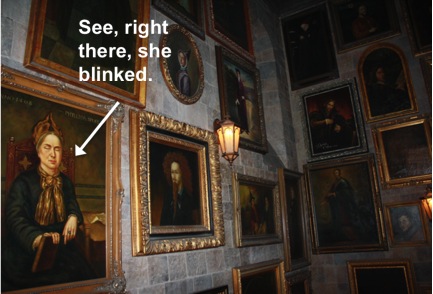
Hall of Portraits, Hogwarts Castle, World of Harry Potter, Universal Studios, Orlando, FL
On the other hand, one of my youngest daughter’s favorite recollections wasn’t eating at great local restaurants, swimming in dozens of different swimming pools, or exploring southern architecture. Nope. It was rescuing someone’s Barbie from a perilous fate.
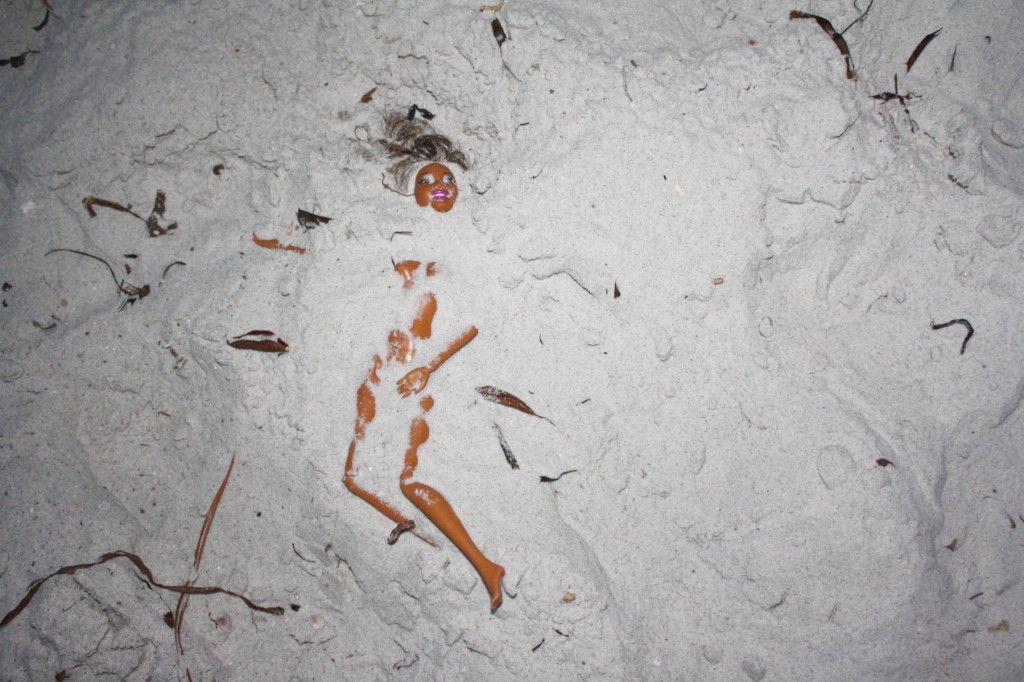
Tortured Barbie left at the beach, owner unknown
She (Barbie) is currently in quarantine.
Mad cat photo © Nikolai Nikonov, text added; all other photos © Karin Blaski; route map © mapquest

By: Kirsty,
on 5/29/2014
Blog:
OUPblog
(
Login to Add to MyJacketFlap)
JacketFlap tags:
Georgia,
Journals,
dogs,
animals,
evolution,
wolves,
*Featured,
oxford journals,
Science & Medicine,
journal of heredity,
heredity,
wolf hybrids,
Earth & Life Sciences,
canis lupus,
David Tarkhnishvili,
dog hybrids,
grey wolf,
caucasus,
hybridization,
tarkhnishvili,
of natia,
kopaliani,
ilia,
natia,
Add a tag
By David Tarkhnishvili
Rapid development of molecular genetics in recent decades has revolutionized our understanding of life and the natural world. Scientists in the 1970s suggested that the grey wolf might be the sole ancestor of domestic dogs, but it was only in 1997 that Carles Vilà, Peter Savolainen, Robert Wayne, and their co-authors provided the conclusive evidence on this based on the analysis of molecular genetic markers.
It is generally assumed that dogs domesticated in East Asia; however, several recent studies challenged this hypothesis. In 2013, a team of scientists showed that the alleles (i.e. different versions of the same gene) of both modern dogs and the fossilized remains from Europe are in fact shared with local wolves.
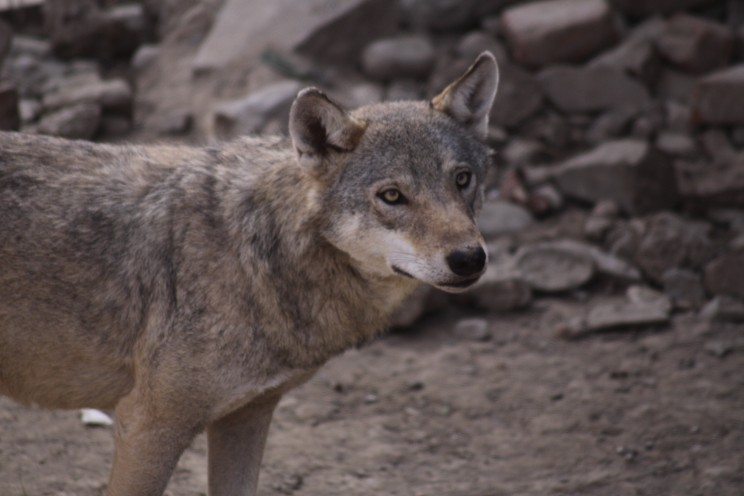
One can suppose that genes of European wolves are descended both from the animals domesticated thousands of years ago and from wild grey wolves, which might hybridize with domestic dogs for thousands of years after domestication. The role of ongoing hybridization in the evolution of dogs is not easy to infer, even with our advanced molecular methods. In Europe and the US, since at least the 20th century, the mating of non-feral dogs (even large-bodied breeds) has usually been under human control. In many tropical countries, where dogs are not controlled so tightly, grey wolves don’t exist at all.
Natia Kopaliani and her co-workers from Ilia State University, Tbilisi, Georgia, have been studying wolf-dog conflict in the Caucasus since 2007. During recent years, they collected and processed samples of both wolves and dogs from the region with molecular genetic methods. Georgia, like other countries of the Caucasus, eastern Turkey, Iran, and Central Asia, has large livestock-guarding dogs, usually called here Caucasian or Georgian shepherds, which are traditionally free-ranging, and have uncontrolled contacts with grey wolves common to the area. The vast majority of the samples in this study were taken from the shepherd dogs guarding herds of sheep in the Central part of the Greater Caucasus Mountains.
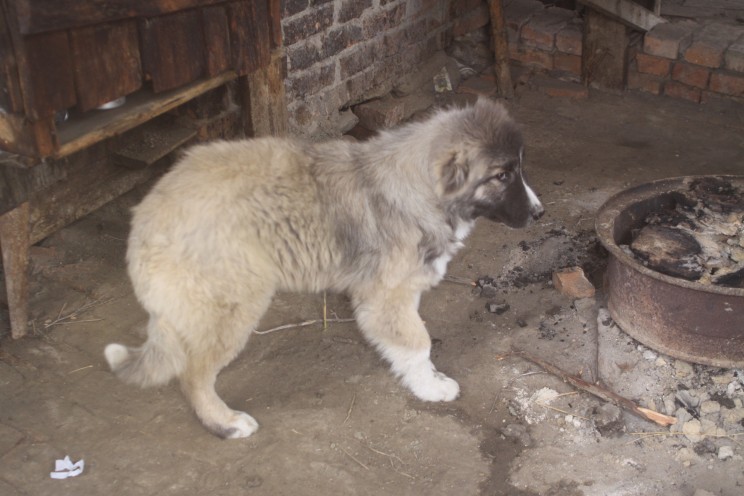
Sequencing mitochondrial DNA showed us that as many as 37% of the dogs shared maternal haplotypes with the local wolves. The proportion of wolves with recent dog ancestry, detected using microsatellite markers, was almost two times higher than that of wolves studied earlier in southern Europe, where feral dogs are still present. More surprising still was that almost the same proportion (nearly 10%) of the guarding dogs possessed the detected hybrid ancestry. These results suggest that mutual gene flow between wolves and dogs in the Caucasus (and, possibly, in other mountainous regions of West and Central Asia) is common, most likely continued for millennia, and had a substantial impact on gene pool of both the domestic and the wild Canis lupus. It does not appear that the hybridization had any negative impact on the dog features important for humans. It is probable that shepherds used to exterminate the hybrids that demonstrated undesired behavior, but that most of the dogs with recent wolf ancestry were integrated into the dog population without problems.
This study may help our understanding of the process of the domestication of dogs and some other domestic animals. Attributing the ancestry of domestic dogs to a few animals from a small area is an oversimplification of the real pattern. Indeed, some domestic lineages may expand faster than the others may. However, wherever both the wild and the domestic forms coexist, they regularly hybridize and we have no reason to think this was not the case all the time since the earliest domestication events. Hybridization may produce animals with undesirable traits, but the owners rapidly eliminate them; occasional hybridization increases effective population size and may help to avoid inbred effect. This isolated, tightly controlled way of dog breeding is a more recent development. Modern dog-keepers select the animals with well-known pedigrees and keep them away from wild animals. Nowadays, it may sound strange to allow a pet dog to interbreed with a wolf. However, the permanent intensive selection of dogs with desirable features was most likely an instrument to keep the breeds “in shape” rather than a peculiar selection of the pedigrees.
David Tarkhnishvili is from the Institute of Ecology, Ilia State University, Georgia. He is a co-author of the paper ‘Gene Flow Between Wolf and Shepherd Dog Populations in Georgia (Caucasus)‘, which appears in the Journal of Heredity.
Journal of Heredity covers organismal genetics: conservation genetics of endangered species, population structure and phylogeography, molecular evolution and speciation, molecular genetics of disease resistance in plants and animals, genetic biodiversity and relevant computer programs.
Subscribe to the OUPblog via email or RSS.
Subscribe to only earth and life sciences articles on the OUPblog via email or RSS.
Image credits: Both images courtesy of Natia Kopaliani, co-author of the paper.
The post Gene flow between wolves and dogs appeared first on OUPblog.


By: Laura A. H. Elliott,
on 9/26/2013
Blog:
Laurasmagicday
(
Login to Add to MyJacketFlap)
JacketFlap tags:
secrets,
Venezuela,
Storytellers,
Caribbean Sea,
The Storytellers,
Bonaire,
Curaçao,
Yuri Knorozov,
Georgia,
Giveaways,
romance,
Blog Tour,
Add a tag
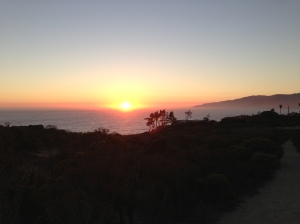
The Storytellers is my latest release and my first adult paranormal romance. It was so much fun to write and came as a bit of a surprise too, when I least expected it. Did you know there are upwards of 50 characters in the book? At E! I had a few opportunities to work on the show E! True Hollywood Stories for eonline.com. I always found the episodes so fascinating. For me it’s really fun to know the story behind the story. I hope you you do too. So, here’s 10 top secrets about The Storytellers, so just keep it between us, ‘kay?  At the end of the post you’ll find the list of giveaway winners, congrats all!
At the end of the post you’ll find the list of giveaway winners, congrats all!
1. Djucu nuts appear as lucky charms in The Storytellers and are considered lucky charms in the Caribbean. The nuts grow in tall trees deep in the Venezuelan jungles then float down waterways and into the Caribbean Sea and onto the beaches of Aruba & Curaçao.
2. My dad called the islands just off the northern coast of Venezuela the “A-B-C islands.” This is how I first learned about Curaçao. Ever since I heard Dad talk about the islands they captured my imagination and is one of the reasons why I chose the island of Curaçao as one of the settings of The Storytellers. (A-B-C Aruba, Bonaire & Curaçao)
3. I visited Venezuela as a teenager and my experiences there influenced a few of the settings in The Storytellers and also influence my writing in general.
4. Dr. Alexandra Abernathy’s story line about archeology is loosely base upon some of the experiences my daughter had while she was on archeological digs in Israel and Jordan.
5. Because of my love of jade, I wanted to use jade as an important part of the cursed treasure in The Storytellers. In Central America The Mayans and Aztecs prized jadite jade. The name jade comes from the Spanish “piedra de ijada” — literally “stone of the pain in the side.” Early Spanish explorers gave it this name after they saw natives holding pieces of the stone to their sides to cure their aches and pains.
6. I wrote The Storytellers years ago and put it in a drawer and never thought I’d ever publish the story. It was only after some friends asked if I had ever written anything for adults that I was prompted to dig out the manuscript.
7. I set part of the novel in Georgia because I’ve had a wonderful time on book tours there and I used to love to look at the beautiful red soil out my window every year when we’d road trip from Chicago to Florida when I was a little girl. I remember one time we drive through the eye of a hurricane just outside of Stone Mountain, GA, a place we’d always overnight on the drive down.
8. The name of the mysterious character, Dr. Yuri Knorozov, is a nod to the Soviet linguist of the same name, (Nov. 19 1922-March 31, 1999) an epigrapher and ethnographer who is renowned for his decipherment of the Maya script.
9. Logograms make up the Mayan language and they captivate me. Each script is a little work of art.
10. One of the hardest parts of the novel for me to write concerned the naming and powers of the four idols at the heart of the story: Escrito holds the power of the writer, which we know as the power of the truth; Bailador, the power of the dancer, which holds the power of falling in love; Pintador, the power of the painter, which embodies the power of perception; and lastly Músico, the power of music, which transcends time and space and holds the power of emotion.
And the WINNERS are

KINDLE FIRE : drecordova
2 signed copies of Storytellers and swagpack: qwertzuio789 and grandmatinaof2
2 copies of Winnemuca: ddoan_562 & bobbyehopebooth
YAY!!! Thanks so much to everyone who followed the blog tour and took the time to enter the giveaway. Y’all rock!
I’m super excited about the paperback which will be available in the next few weeks. I’ve gotten lots of requests about its availability. And also, the book trailer is coming soon, stay tuned.



By: ErinF,
on 1/21/2013
Blog:
OUPblog
(
Login to Add to MyJacketFlap)
JacketFlap tags:
fulton,
Online Products,
fulton county,
Georgia,
History,
statistics,
US,
Sociology,
Data,
african american,
African American Studies,
census,
Martin Luther King Jr. Day,
Research Tools,
martin luther king jr,
county,
Editor's Picks,
*Featured,
social explorer,
Sydney Beveridge,
demography,
Add a tag
By Sydney Beveridge
Martin Luther King, Jr. was the legendary civil rights leader whose strong calls to end racial segregation and discrimination were central to many of the victories of the Civil Rights movement. Every January, the United States celebrates Martin Luther King, Jr. Day to honor the activist who made so many strides towards equality.
Let’s take a look at the demographics of the legendary man’s hometown then and now to see how it has (and has not) changed. King was born in 1929, so we’ll examine Census data from 1930, 1940, and the latest Census and American Community Survey data.
His boyhood home is now a historic site, situated at 450 Auburn Avenue Northeast, in Fulton County (part of Atlanta). In 1930, Fulton County had a population of 318,587 residents. A little over two thirds of the population was white (68.1 percent) and almost one third of the population was African American (31.9 percent). Today, the 920,581-member population split is nearly even at 44.5 percent white and 44.1 percent African American, according to 2010 Census data. Fulton’s population is more African American than the United States as a whole (12.6 percent), but not as as much as Atlanta (54.0 percent).
A closer look at 1940s Census data of the Atlanta area offers more detail about where the black and white populations lived. The following map shows the distribution of the black population in the Atlanta of King’s youth. Plainly, African Americans lived together, largely apart from whites.
African American Population in Fulton County, GA, and Surroundings, 1940 (click map to explore)
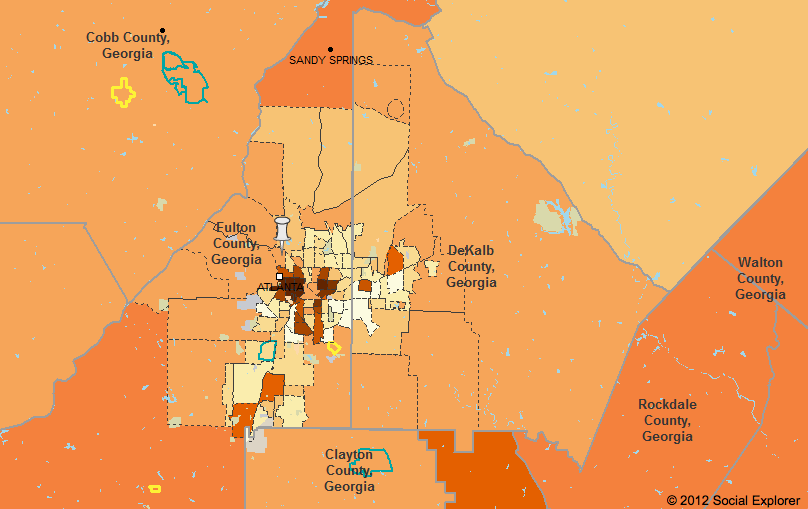
For comparison, the following map shows where the black population lives today. Now the black population has expanded in the metro area, but still seems to be quite segregated.
African American Population in Fulton County, GA, and Surroundings, 2010 (click map to explore)

Reflecting on a century after the end of slavery, King said in his famous “I Have a Dream” speech of 1963:
But one hundred years later, the Negro still is not free. One hundred years later, the life of the Negro is still sadly crippled by the manacles of segregation and the chains of discrimination. One hundred years later, the Negro lives on a lonely island of poverty in the midst of a vast ocean of material prosperity. One hundred years later, the Negro is still languished in the corners of American society and finds himself an exile in his own land. And so we’ve come here today to dramatize a shameful condition.
The quest for equal rights and freedoms made up part of a larger vision. In 1967, he spoke of aspiring for full equality at a speech at the Victory Baptist Church in Los Angeles:
Our struggle in the first phase was a struggle for decency. Now we are in the phase where there is a struggle for genuine equality. This is much more difficult. We aren’t merely struggling to integrate the lunch counter now. We’re struggling to get some money to be able to buy a hamburger or a steak when we get to the counter…
He went on to say that this would require a commitment of not only political initiative but also money: “It didn’t cost the nation one penny to integrate lunch counters. It didn’t cost the nation one penny to guarantee the right to vote. The problems that we are facing today will cost the nation billions of dollars.”
In 1968, King and other activists launched the Poor People’s Campaign, advocating for economic justice to address these imbalances in opportunity and resources. A few months later, he was assassinated.
We can look at different socioeconomic indicators to measure the country’s progress towards equality. According to 1940 Census data, more than a third (36.5 percent) of housing units in Fulton County where whites lived were owner occupied, compared to less than a seventh (14.0 percent) of the housing units where African Americans lived.
Today, home ownership increased for both groups, but the gap remains. Two thirds (66.6 percent) of white households are owner-occupied, compared to two fifths (41.7 percent) of all black households.
Home Ownership Comparison in Fulton, GA, by Race
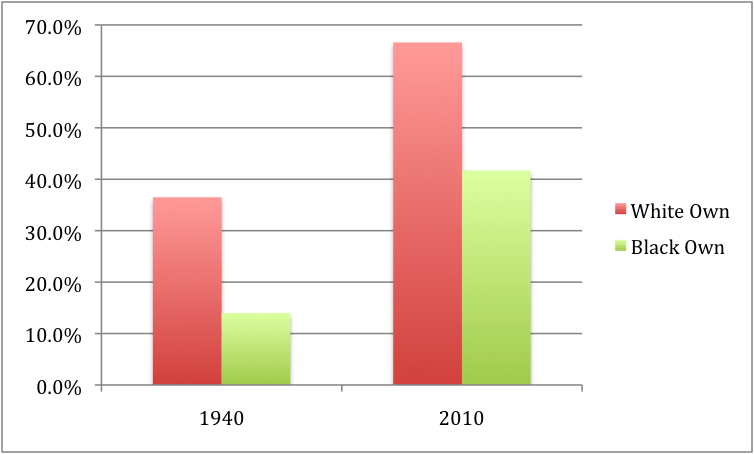
Let’s examine other measures of equality to see examples of additional gaps.
The unemployment rate is nearly twice as high among African Americans (17.9 percent) compared to among whites nationwide (9.5 percent). That gap is even more pronounced in Fulton County, where the unemployment rate for whites is 7.7 percent, while the unemployment rate for African Americans is 20.4 percent.
The percent of those living below poverty is also higher in the black community (27.2 percent) than in the white community (12.5 percent). While both groups are better off in Fulton County than the rest of the US, the poverty rate gap is even larger (8.2 percent among whites and 26.6 percent among African Americans in Fulton).
Similarly, while both groups are better educated in Fulton County compared to the rest of the US, nearly two thirds (62.4 percent) of white adults in the county have BA degrees or more, while just one quarter (25.3 percent) of the black population have the same level of education. The college attainment gap is 11.6 percentage points nationwide, but 37.1 percentage points in Fulton County.
While much progress towards freedom and equality has been made since King’s time, chronic gaps persist, even in his own backyard. The data show that 50 years after the “I Have a Dream Speech,” equal opportunity and socioeconomic status continue to lag behind equal rights.
Sydney Beveridge is the Media and Content Editor for Social Explorer, where she works on the blog, curriculum materials, how-to-videos, social media outreach, presentations and strategic planning. She is a graduate of Swarthmore College and the Columbia University Graduate School of Journalism. A version of this article originally appeared on the Social Explorer blog. You can use Social Explorer’s mapping and reporting tools to investigate dreams, freedoms, and equality further.
Social Explorer is an online research tool designed to provide quick and easy access to current and historical census data and demographic information. The easy-to-use web interface lets users create maps and reports to better illustrate, analyze and understand demography and social change. From research libraries to classrooms to the front page of the New York Times, Social Explorer is helping people engage with society and science.
Subscribe to the OUPblog via email or RSS.
Subscribe to only American history articles on the OUPblog via email or RSS.
The post Checking in on Martin Luther King, Jr.’s dream, with data appeared first on OUPblog.


By: Lauren,
on 8/18/2011
Blog:
OUPblog
(
Login to Add to MyJacketFlap)
JacketFlap tags:
Georgia,
taiwan,
Geography,
World,
Russia,
phantoms,
Thought Leaders,
Eritrea,
phantom,
*Featured,
Law & Politics,
a high price,
daniel byman,
statehood,
charles king,
phantom state,
South Ossetia,
ossetia,
karabakh,
nagorno,
Add a tag
By Daniel Byman and Charles King
Three years ago this month, Russia and Georgia fought a brief and brutal war over an obscure slice of mountainous land called South Ossetia that had declared its independence from Georgia. Flouting international law, Russia stepped in to defend South Ossetia and later formally recognized the secessionists as a legitimate [...]


By: Brian Minter,
on 3/28/2011
Blog:
First Book
(
Login to Add to MyJacketFlap)
JacketFlap tags:
teens,
Georgia,
young adults,
teenagers,
First Book,
Book Distributions,
Florida,
Oklahoma,
Rhode Island,
Walmart,
Alabama,
Kyle Zimmer,
teen readers,
First Book Partners,
Add a tag
“With this grant, our library was able to purchase 100 books for our library collection, as well as provide books for 87 preschoolers from low-income families. With proration hitting so many non-profits, it was truly a blessing to receive this grant for our library. HOOORAY to FIRST Book and Walmart for helping us!”
– Debra Grayson, White Smith Memorial Library, Jackson, AL

First Book was able to distribute over 75,000 brand-new books to teen and young adult readers in Alabama, Florida, Rhode Island, Oklahoma and Georgia, thanks to support from the Walmart State Giving Program.
Fifty programs in each of the five states received a $500 credit for the First Book Marketplace, our online store available exclusively to programs serving children from low-income communities. In addition, programs across those states received thousands more books – free of charge – from our National Book Bank.
“In the past we haven’t been able to provide books to older readers to the extent needed,” said Kyle Zimmer, First Book’s president and CEO. “But that’s changing fast; the selection of young adult titles we’re able to offer to our network of schools and programs is growing, and we’re on track to deliver even more resources to this under-served group this year.”
We know how hard teachers and program leaders are working to get teenagers reading, so we’re excited to be able to offer more books that appeal to older readers, and get them into the hands of kids that need them.
If you work with young adults, get in touch or leave a comment below, and let us know about the books they’re interested in and what we could do to help your program.


By:
Chris Singer,
on 1/16/2011
Blog:
Book Dads
(
Login to Add to MyJacketFlap)
JacketFlap tags:
News,
children's books,
book reviews,
Georgia,
Book Review,
Atlanta,
peachtree publishers,
book dads,
Featured Post,
dads reading,
Contributor: Chris Singer,
Add a tag
 This week I’m featuring reviews of books by one of my favorite book publishers – Peachtree Publishers.
This week I’m featuring reviews of books by one of my favorite book publishers – Peachtree Publishers.
Peachtree Publishers is an independently owned trade book publisher, specializing in quality children’s books, from picture books to young adult fiction and nonfiction. They also publish self-help titles covering education, parenting, psychology, and health along with walking, hiking, fishing guides from the South (Peachtree is based in Atlanta, GA).
Besides offering high quality books, Peachtree Publishers offer many resources for their readers and customers including: Teacher Guides, Information on Guided Reading Levels, Book Trailers, Information on Author Visits to Schools and more.
You can catch the latest news from Peachtree by visiting their blog: The World of Peachtree Publishers. By the way, please congratulate them on their first Blog-O-Versary!!
This week Book Dads will feature reviews of four books from Peachtree Publishers:
Tuesday, January 19th: Hey Daddy! Animal Fathers and Their Babies by Mary Batten
Wednesday, January 19th: Flying by Kevin Luthardt
Thursday, January 20th: That’s Not How You Play Soccer, Daddy! by Sherry Shahan
Friday, January 21st: Rolling Along – The Story of Taylor and His Wheelchair by Jamee Riggio
There will be more reviews of some newly released Peachtree books coming out later this Winter and Spring.

By: HannaO,
on 11/29/2010
Blog:
OUPblog
(
Login to Add to MyJacketFlap)
JacketFlap tags:
*Featured,
Americus,
E. Stanly Godbold,
Rosalynn Carter,
Rosalynn Smith,
rosalynn,
lillian,
Georgia,
History,
Biography,
US,
Politics,
Plains,
Jimmy Carter,
carter,
jimmy,
Add a tag
The holiday season is upon us, and that turns many minds to thoughts of spending time with loved ones. Below is an excerpt from Jimmy & Rosalynn Carter: The Georgia Years, 1924-1974 by E. Stanly Godbold, Jr. tracing the early romance of the former President and First Lady.
In the hot, dusty summer of 1945, people in Plains talked about the heat, the crops, and the war, unaware of an event on Main Street that three decades later would catapult their town onto the world stage. Jimmy Carter, the twenty-year-old eldest child of a prominent local family, was visiting his hometown before returning for his final year at the Naval Academy. As he drove down Main Street in a Ford car with a rumble seat, accompanied by his sister Ruth and her boyfriend, he glanced toward the Methodist church. There he spied a pretty young woman loitering on the steps. Petite Rosalynn Smith, with her large, warm, intelligent eyes, exuded a seductive shyness that captivated the Academy man. Graduated as valedictorian of her class at Plains High School, she had completed one year at a nearby junior college. Jimmy stopped the car, not knowing that Ruth and Rosalynn had conspired to set up the meeting. He invited Rosalynn to attend the movie at the Rylander Theater in nearby Americus that night. She accepted.
Rosalynn was seventeen and Jimmy twenty that night in 1945 when they had their first date. His white Navy uniform dazzled her, and he thought her ravishing in her blue dress that buttoned all the way down the front. Immediately after their first date, Jimmy told his mother that he had met the woman he intended to marry. Lillian disapproved. “Jimmy, she’s just a little girl! She’s Ruth’s friend,” she argued. Lillian thought that Jimmy was much more sophisticated than “naïve” Rosalynn Smith of Plains, Georgia.
Rosalynn’s father lacked the powerful personality and wealth of Earl Carter, and neither her mother nor any woman in Plains could equal Miss Lillian. Yet, connected by blood to the Wises, Murrays, Bells, and Smiths, her pedigree, ever so important in a small southern town, was superior to that of the Gordys or Carters. Because her father died when she was young and her mother remained imprisoned in shyness, Rosalynn had no influential, potent adults to push her into the world. What she had was a robust spirit, a vigorous will, an inquisitive intellect, an energetic mind, an unspoken ambition, a quiet faith, and a tough ability to succeed at whatever she undertook.
It would take Jimmy a decade of marriage to realize the complements to his lifestyle that Rosalynn brought to their union. On their first date, he saw a very pretty, smart, seductively shy girl who smiled at him. Rosalynn did not fall so quickly for him, but she later confessed that she had fallen in love with a picture of him in his uniform. She realized that the man in that uniform, who now said he loved her, had begun to see that world about which she only read and dreamed. The young lovers exchanged a flurry of letters, a correspondence that did not mention the major events of the day, but consisted of, according to Carter, “intimate love letters.”
World War II ended shortly after their courtship began. Rosalynn did not want Jimmy to go to war, but she remained reticent. He teased her about falling in love with his uniform, and he pretended to date other women. On at least one occasion, Jimmy did go out with another woman, and he suggested that Rosalynn see other men. When she reciprocated with letters about nonexistent boyfriends, he bristled, but they soon put aside their jealousies and committed to each other.
When Jimmy returned home on his Christmas leave in 1945, he and Rosalynn sang Christmas carols before open fires and attended church and parties together. Rosalynn beamed beside Jimmy in his dress blue uniform. He teased her mercilessly, a Carter family trait indicating aff
More research for the picture book I'm illustrating, "The 12 Days of Christmas in Georgia." Did you know that Springer Mountain is the beginning of the Appalachian Trail? Well, it's in Georgia and makes for a lovely bimble.
This past weekend, we headed up to North Georgia and stopped at R&A Orchards for lunch and peaches!
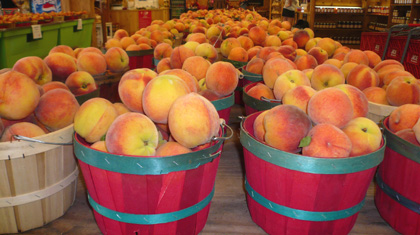
 And then we headed for the mountain. About 20 minutes in on a National Forest road and we were there! Well, sort of. We parked the car and then hiked a mile uphill. THEN we were there!
And then we headed for the mountain. About 20 minutes in on a National Forest road and we were there! Well, sort of. We parked the car and then hiked a mile uphill. THEN we were there!
And boy was it worth the trip - it was gorgeous.
There are two plaques when you get to the official start of the AT - you can see one of them in front of Stan (the hubsmeister) embedded in the rock and the other in this second shot. There's also a mailbox of sorts built into the back of the rock to hold notebooks for geocachers and notes/postcards people want to leave for whoever is there next. Pretty cool.
We also checked out the camping set-ups nearby, and dang. It's like five-star camping up there! And if it wasn't for the bears (which have been problematic of late according to a posted sign) I'd be all over it.


It's going to be tricky to illustrate this one. If any of you are hikers, you know that the view surrounding you most of the time is pretty limited in scope (rocks, trees, the uphill climb). Every now and then you come to an open vista like the pic above, however, it can be hard to relate that information to surrounding context. So, it will be challenging to draw. But now that I've been there, I have a much better idea of how to tackle it!
By: Stacy Dillon,
on 4/11/2009
Blog:
Welcome to my Tweendom
(
Login to Add to MyJacketFlap)
JacketFlap tags:
Farrar Straus Giroux,
grandparents,
first crushes,
watermelons,
Georgia,
family,
farming,
death,
2008,
Add a tag
 I am happily getting into a ritual of biweekly visits to the public library with my daughters. While they are off perusing the picture book shelves, I head on over to fiction to find some more tweeny titles. Hummingbird, by Kimberly Green Angle ended up in my pile this week.
I am happily getting into a ritual of biweekly visits to the public library with my daughters. While they are off perusing the picture book shelves, I head on over to fiction to find some more tweeny titles. Hummingbird, by Kimberly Green Angle ended up in my pile this week.
March Anne lives on her family's watermelon farm with her dad, brother Kevin and Grenna. March Anne's mom died when she was quite young, so Grenna has been like a mom to her ever since. Daily pieces of March Anne's life are taken up soaking in Grenna's advice and particular sayings.
Then right in the middle of the watermelon harvest, Grenna collapses in the field. March Anne knows that her life is about to change forever. Even though Grenna comes home, the doctor's words of "irreparable damage" stay with her.
March Anne tries to keep on. She has her friends Meg and Laverne, of course, and there is the daily grind of school to follow. Her Daddy tells her that cooking is now up to her, and with disastrous results, March Anne is feeling a bit more useless than she would like.
Hummingbird is a slow, simmering family story. To be honest, the pace at first made me consider putting this one aside, but I am glad that I kept on. The characters are refreshingly honest and humble, and when the inevitable happens at the end, tears are sure to come. Give this to thoughtful readers who like quiet stories.
Atlanta is home to many wonderful and diverse Kane/Miller customers. We're pleased to share with you the following accounts that carry our books:
Richard's Variety
Charis: Books and More
Tall Tales Book Shop
2105 Lavista Road
Atlanta, GA 30329
Junkman's Daughter
Sprout: a children's store
It's a Baby
High Museum of Art
Kangaroo Pouch
56 E Andrews Dr NW
Atlanta, GA 30305
Atlanta Botanical Garden
Fernbank Museum of Natural History
Martinis & IMAX (What a brilliant idea!)
*If your store is in Atlanta and you carry Kane/Miller titles, please let us know! We certainly didn't mean to exclude anyone and want to highlight every place we can. Links to your website are greatly appreciated! Additional cities will be featured in future City Editions of the Kane/Miller newsletter and blog.
Many news sources including USA Today and Yahoo News are reporting that Superior Judge Ronnie Batchelor upheld a decision by the Georgia Board of Education to support the Gwinnett County School Board in its decision to keep the Harry Potter books in the school libraries.
 Laura Mallory, mother of four children, two of which attend schools in Gwinnett county has spent years trying to remove the Harry Potter books, arguing that the books are indoctrinating children in witchcraft. At the last hearing, Mallory argued that having books in the library that she believes promote witchcraft is a violation of the separation of church and state, since some people practise witchcraft as a religion.
Laura Mallory, mother of four children, two of which attend schools in Gwinnett county has spent years trying to remove the Harry Potter books, arguing that the books are indoctrinating children in witchcraft. At the last hearing, Mallory argued that having books in the library that she believes promote witchcraft is a violation of the separation of church and state, since some people practise witchcraft as a religion.
The American Libary Association (ALA) identifies the Harry Potter series as the most challenged books of the 21st century.
For more pictures and news on the Harry Potter series, visit Yahoo News.
"Helping others from the terror within!" is the slogan on Laura Mallory's MySpace site. Visit there to read her perspective.

It will come as no surprise to anyone who follows the censors, when (not if) J. K. Rowling's last Harry Potter book is challenged in schools. But before that happens following the July 21, 2007 release, here is a look at the U.K. and American versions of the cover for Harry Potter and the Deathly Hallows.
According to an article by Margaret Rees from the World Socialist Web Site dated from 2000,
The reason for the challenges to the Harry Potter books centre round their focus on wizardry and magic. Fundamentalist Christians claim the series is subversive, because wizardry is incompatible with Christian belief. According to them, it is presenting witchcraft in an attractive light and desensitising young people to its dangers. They are hostile because in their opinion Rowling has a false world view, that is, she does not write from the standpoint of Christian ethics.
In a highly publicized case, Laura Mallory began a crusade in November 2005 to have Harry Potter books removed from Gwinnett Public Schools in Georgia. She lost an appeal with the Georgia State Board of Education, in 2006, to have the books banned from the schools.
There is an interesting
German article about Harry Potter books that explains how the books were removed from the curriculum of a state-run school. Julia Bonk, the education-policy spokeswoman in the legislature's Left party parliamentary group criticized the school's action,
(By acquiescing to the request,) the school director is essentially inviting religious fundamentalists to interfere with the educational and academic goals of state-funded schools, according to their discretion. The lesson plans of state-funded schools should not be subject to approval by people who hold all possible religious convictions.
And this time she has an "expert witness":
Mallory said she's ready for a legal fight. She said she's already contacted a potential expert witness to lend support to her case. And she said supporters who urged her to continue the case have sent her "significant donations" to help pay legal fees.
So. The school wouldn't ban the Harry Potter books, so she went to the school board. They wouldn't ban them, so she went to the State Board of Education. They wouldn't ban them, so now she's bringing it to Gwinnett County Superior Court. (I may have missed a step there. Did she bring it to the County Board of Education before the State Board?)
At what point will she realize that it just isn't going to happen? And who are the "supporters" who have given her "significant donations" to further the case? How much money are we talking here?
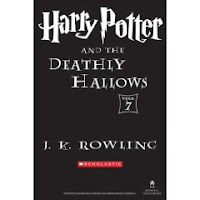 Yesterday, J. K. Rowling announced the title of book seven of the Harry Potter series. This series has met with many challenges, the latest in Georgia where Laura Mallory, a Christian parent has lost the fight to ban the book from Gwinnett County.
Yesterday, J. K. Rowling announced the title of book seven of the Harry Potter series. This series has met with many challenges, the latest in Georgia where Laura Mallory, a Christian parent has lost the fight to ban the book from Gwinnett County.
Check out La Shawn Barber's Corner to hear another Christian's point of view concerning Harry Potter.
Harry Potter books are challenged on such a regular basis that I don't even bother trying to keep up on this site. This is the 115th time the books have faced a challenge, according to the American Library Association.
See the play by play of the Georgia Board of Education in this slide show at Yahoo.





















 And then we headed for the mountain. About 20 minutes in on a National Forest road and we were there! Well, sort of. We parked the car and then hiked a mile uphill. THEN we were there!
And then we headed for the mountain. About 20 minutes in on a National Forest road and we were there! Well, sort of. We parked the car and then hiked a mile uphill. THEN we were there! 






The magic is just the window dressing. If you look at the morality play going on in Potter, there are many lessons to teach. There's even an unauthorized version called "The Gospel According to Harry Potter". Christians who don't look beneath the surface of a book before banning it are probably not going to look too deeply into their own Book.
My only question is if every kid owns Harry Potter books, why do we need to spend taxpayer's money to buy them another copy. I say by all means use Harry Potter books in Reading class, but kill two birds with one stone and save a few bucks. Tell the kids BYOB.
Informative post. Thanks.
I agree with you about the morality play being below the surface of this tale. The same goes for many books that are challenged: Lowry's The Giver, L'Engle's A Wrinkle in Time (which challenged me to see God and the universe with new eyes as I read it as an adult), Paterson's Bridge to Terabithia, and so many more. When you break any book down into its rawest form, couldn't you say it is about the struggle between good and evil and where humans draw the line?
Good observation about having the kids bring their own books. The German story made it sound like it was a class text and that all of the children were reading it.